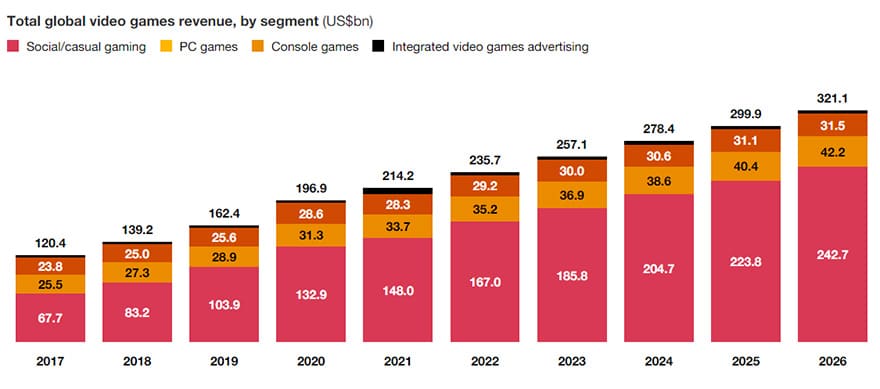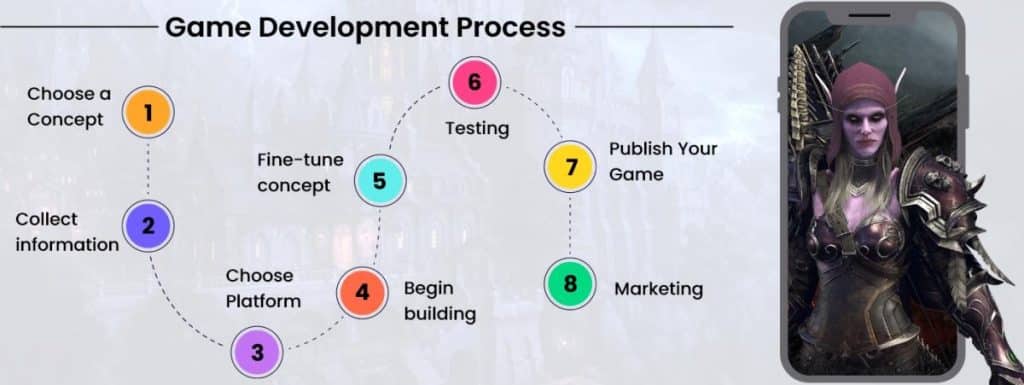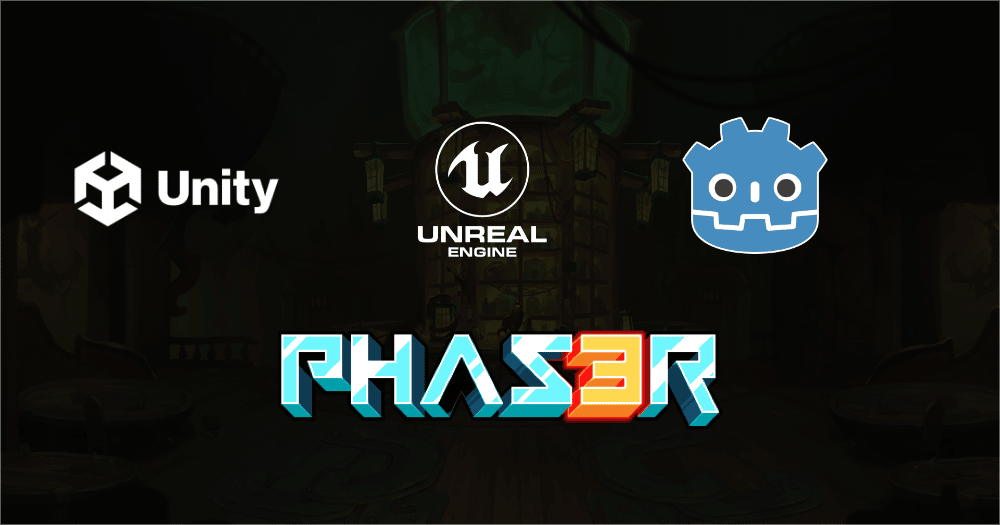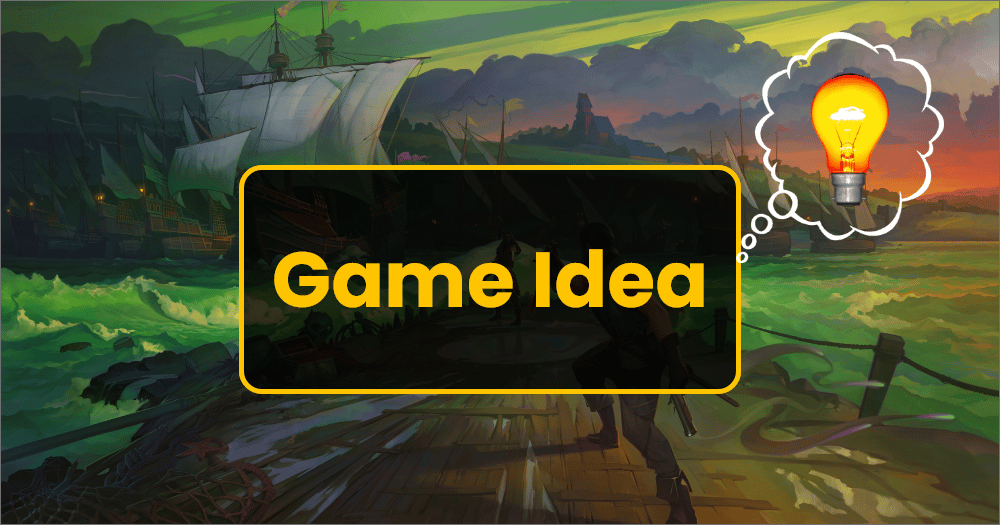The video game industry is booming with a wide variety of games available to suit every taste whether it’s AAA games or indie games such as Fortnite, Minecraft, and PUBG. In 2025, the global video game market will amount to 268.8 billion dollars annually. In this guide we will explore how to create a video game in scratch.
However, there is a clear demand for AAA games, which is a big-budget titles produced by a major Video game Development companies. These games tend to be very polished and well-made, with high production values. Indie games, on the other hand, are usually created by smaller teams or even individuals.
They often have a more unique or experimental style and can be a great way to support new talent. Video Game development is a complex process, requiring talented game animators, video game developers, and game designers to come together to create a successful game. Unity and Unreal Engine are the most popular game engines, due to their flexibility, ease of use, and support to design and develop cross-platform games.

Source: Game Industry
It’s time to learn how to make a video game with the help of various game development tools, so let’s get started.
How to Create a Video Game?

1. Planning to Make a Video Game
The first step in game development is to come up with an attractive video game name idea. This will be the title of your game and it should be unique and catchy. It should also be relevant to the niche you are targeting. For example, if you are developing a game for kids, you might want to choose a name that is related to animals or perhaps a character from a popular kids’ movie.
Once you have finalized your game name, the second step in planning a video game is to come up with a great storyline. This is the foundation of the game, and it needs to be compelling and engaging. Once you have a great storyline, you can start to develop the concept.
What are the unique key features that will make your game stand out from the crowd? Who is your target audience? These are all important questions that need to be answered before you can move on to the next step in game development. With a solid foundation in place, you can start to bring your vision for the game to life.
2. Pre-production of Video Game Development Process
After the initial planning stages, it’s time to start putting together a team to help you develop your game. Depending on the size and scope of your project, you may need to hire programmers, artists, animators, audio engineers, and other professionals. Once you have your team in place, it’s time to start working on the game itself.
This is the phase where the game’s concept is fleshed out and a prototype is created. During pre-production, the game’s design document is created. This document contains all the information about the game, including its mechanics, storyline, and characters.
The prototype is also created during this phase. The prototype is a rough version of the game that is used to test the gameplay mechanics. After the concept and prototype are complete, the game enters production.
The game design document is a crucial part of any video game development project. It outlines the game’s concept, mechanics, and other important aspects of the design. The GDD is used to communicate the game’s vision to the development team and ensure that everyone is working towards the same goal. Without a well-crafted GDD, it would be very difficult to develop a high-quality video game.
The document is also beneficial for keeping track of ideas and making sure that nothing is forgotten during development. For these reasons, a game design document is an essential tool for any game developer.
3. Production
The third stage of game development is production. This is where the game is actually made using one of the best game engines available. Once the game engine is chosen, the development team can start creating the game. This process can take several months or even years, depending on the complexity of the game.
first, we need to create a prototype, which is a basic version of the game that can be used to test gameplay mechanics. Once the prototype is approved, the team will begin work on the full game. During this process, they will create assets such as character models and level designs.
4. Testing
Testing is an essential part of any game development project, and video games are no exception. In fact, given the complex nature of video games, testing is even more important for ensuring that the game is fun and playable.
There are two main types of testing: internal testing and external testing. Internal testing is conducted by the development team during the production stage. External testing is conducted by people who are not part of the development team, such as beta testers.
Both types of testing are important for finding bugs and ensuring that the game is enjoyable. However, external testing is often more effective, as it provides a fresh perspective and can help to identify issues that the development team may have missed. Testing is an ongoing process that should be carried out throughout the entire development cycle, from pre-production to post-release.
5. Pre-launch
The pre-launch stage of game development is critical for ensuring the success of a game. During this stage, the game’s marketing and PR plans are put into action, and the team works to generate buzz and excitement for the game. Additionally, this is the time when any final bugs and glitches are ironed out, and the game is polished to perfection.
This stage can be stressful for developers, as there is a lot riding on the success of the game. However, it is also an exciting time, as the team gets to see their hard work finally come to fruition. With a well-executed pre-launch plan, a game can set itself up for a successful launch and a long life on the app store.
6. Launch Your Own Video Game
After months or even years of hard work, the moment of truth has arrived: it’s time to launch your game. Of course, there’s still a lot riding on this final stage of development. All your previous efforts will be for nothing if the game is buggy or unappealing to players.
Fortunately, there are a few things you can do to set yourself up for success. First, make sure you have a solid plan in place for post-launch support, including patching, customer service, and marketing. Secondly, create a comprehensive marketing campaign that will generate buzz and excitement for your game.
Finally, don’t forget to celebrate! Launching a successful game is an incredible accomplishment, so take the time to enjoy it with your team. With a little planning and effort, you can make sure your game is met with critical and commercial success.
7. Post-Release
After a game is launched, the development team will move into the post-launch phase. This is where they will monitor player feedback and make changes to the game based on that feedback. They will also work on fixing any bugs that are found and ensuring that the game continues to run smoothly.
In addition, they will continue to add new content to the game on a regular basis. This could include new levels, characters, or features. The post-launch phase can last for months or even years, and it is vital for ensuring that a game remains enjoyable for players over the long term.
Team Required to Make a Video Game
When it comes to game development, there are a lot of moving parts. From the initial concept to the final launch, there is a lot that goes into making a video game. And while each team member plays a vital role in the development process, there are some roles that are more important than others.
1. Project Manager
The project manager is responsible for overall coordination, management, and execution of the game development process. They work with all members of the development team to ensure that the game is on track and meeting deadlines. Additionally, they liaise with external partners, such as publishers and platform holders.
2. Game Designer
The game designer is responsible for coming up with the initial concept for the game and fleshing out its mechanics and features. They work closely with the rest of the development team to ensure that the game is fun and playable.
3. Game Developers / Programmers
The game developers are responsible for actually building the game. They take the game design and turn it into a working product. This involves programming the game’s logic, designing the user interface, and creating any other necessary paid and free game development softwares.
4. Level Designers
The level designers are responsible for creating the game’s levels. They work with the game designer to come up with creative and challenging-level designs that fit the game’s theme and mechanics. Additionally, they create any necessary art and animations for the levels.
5. Game Artists
The game artists are responsible for creating the visual style of the game. This includes designing the characters, environments, and user interface. They work closely with the level designers to ensure that their art fits within the game’s levels.
6. 3D Modelers
The 3D modelers are responsible for creating the game’s three-dimensional assets. This includes characters, environments, and props. They work closely with the game artists to ensure that their models fit within the game’s art style.
7. Game Animators
The game animators are responsible for animating the game’s characters and objects. This includes movements, facial expressions, and any other necessary animations. They work closely with the 3D modelers to ensure that their animations look good on the game’s models.
8. FX Artists
The FX artists are responsible for creating the game’s visual effects. This includes explosions, fire, smoke, and any other special effects that are needed. They work closely with the game animators to ensure that their effects look good on the game’s animations.
9. Audio Engineers / Sound designers / Composers
The audio engineers are responsible for creating the game’s sound effects and music. This includes recording and editing sounds, as well as composing original music. They work closely with the FX artists to ensure that their sound effects fit within the game’s visual effects.
10. QA Tester / Game Tester
The QA tester is responsible for testing the game during development. They play through the game and look for bugs or other issues. Additionally, they provide feedback on the game’s design and mechanics. They work closely with the developers to ensure that any issues are found and fixed before the game is released.
How to Select the Best Video Game Engine?

We’ve got an idea in our heads and a plan on paper (hopefully), so now let’s move to know what are game engines and So Game engines – what are they? So the term “gaming engine” refers to a software development environment, often known as a “game architecture” or “software framework,” accessible with settings and configurations that facilitate and optimise the creation of video games in a range of programming languages.
The core features that a game engine provides:-
- Rendering
- Collision detection
- Artificial intelligence
- Calculating physics
- Input
- Scripting
- Playing animations and sounds
Now you must be wondering to know about the different types of game engines, then take a quick glance at below table:-
| Gaming Engines | Pricing | Examples | Supports 2D/3D |
|---|---|---|---|
| Unity | Free for personal use. Paid plans start at $35 per month. | Osiris: New Dawn
Hollow Knight Genshin Impact |
Both |
| Unreal Engine | Free (royalty on gross revenue) | Soulcalibur VI
Gears 5 Dragon Quest XI |
Both |
| Godot | Free | ProtoCorgi
Deep Sixed Gun-Toting Cats |
Both |
| Phaser | Free | Magikmon
Gems ‘n Ropes Pickem’s Tiny Adventure |
2D Only |
| GameMaker: Studio | Memberships start at $39 per month. | Hyper Light Drifter
UNDERTALE Forager |
2D Only |
1. Unity
Unity, a multi-platform gaming engine allows developers to develop immersive 2D and 3D content combinedly. Its all-in-one editor is compatible with several platforms, including Windows, Mac, Linux, IOS, Android, Switch, Xbox, PS4, Tizen, and others. The intuitive interface facilitates the development process easier.
2. Unreal Engine
A powerful 3D graphics engine, Unreal Engine owned by Epic Games. Due to its robust graphical capabilities with lighting, shaders, and more, Unreal Engine is the powerhouse behind many of the most popular triple-A games out there today. The Best thing about Unreal Engine is that it runs on several platforms Xbox One, PS4, PC, iOS, Android, Mac OS X, Linux, and VR.
3. Godot
A free and open-source game engine, Godot was released with a very permissive MIT license. Initially, it was created for several companies in Latin America, before its public release. Godot’s gaming engine runs on Windows, macOS, and Linux and can create games for PCs, mobile devices, and the Web platform.
4. Phaser
Phaser was first introduced in 2013, however, the most recent version, Phaser 4, was released in 2019. Even as new versions are released, Phaser is a pretty stable framework based on web development technology. In addition, Phaser provides physics and all the other capabilities you’d anticipate from a gaming engine, allowing you to create any game, including MMORPGs.
5. GameMaker: Studio
GameMaker has grown in popularity, as it doesn’t require programming skills to use. Instead of writing in a local language, users can “point-and-click” to build games considerably more quickly. The top games created with GameMaker are Super Crate Box, Hotline Miami, and Spelunky.
What Types of Games Can You Create?

The type of game you’re going to make is probably also something you know beforehand. You can develop games for different types of games. Here is a detailed list on video game ideas.
- Action Games- Action games, one of the oldest game genres, emphasize testing the player’s reflexes, hand-eye coordination, and reaction times. Call of Duty, Street Fighter, and Temple Run are good examples of action games.
- Action-adventure Games- Action-adventure games, the earliest recognisable hybrid genre, have a strong focus on plot and battle through engaging stories and precise gameplay mechanisms. Therefore, many games including the iconic Legend of Zelda perfectly fit into this category.
- Role-playing Games- In a role-playing game (RPG), the player takes control of a fictional character who sets off on an adventure in an imaginary world. Some of the great role-playing games are Dungeons and Dragons, Battletech, and Star Wars.
- Simulation Games- Simulation games are a genre of games that are designed to mimic activities you’d see in the real world. Minecraft and The Sims are good examples of simulation games.
- Strategy Games- Games in the “Strategy” genre are largely concerned with strategic planning to defeat opponents or accomplish objectives. The Age of Empires series, the Total War series, and games like X-COM 2, Cities: Skylines, SimCity: BuildIt, and Civilization V are some famous examples of this genre.
- Sports Games- Sports video games replicate several sports, including baseball, basketball, football, golf, and soccer. They can also include Olympic sports like skiing, and even pub sports like darts and pool. In these games, the opponents are occasionally controlled by computers, but they can also be real people.
- Puzzles Games- Puzzle games put the player to test their brains in terms of logic, pattern identification, solving sequences, and word completion. Puzzle games continue to find millions of fans, especially on mobile phones where games like Candy Crush Saga are extremely popular.
- Idle Games- Not to be confused with casual gaming, idle games are simplified games that involve minimal player involvement, such as clicking on an icon over and over. Idle games keep players engaged by rewarding those who complete simple objectives.
How Much Does It Cost to Create a Video Game?
Depending on your project requirement, an average game development cost is around $265 million. Let’s get into more detail- there are different types of games like AAA or Indie games, so for indie games, it will cost between $50,000 and $700,000 to make from scratch, whereas AAA games can cost around $80 million.
Apart from this video game development costs may vary on the following factors.
- Geographical location
- Complexity of the game
- Functionality and Design
- Chosen platform
- Experience of the team
Conclusion on Steps to Build a Video Game
It takes time and effort to answer the question: how to create a video game? It also won’t happen overnight for you to learn these skills of the gaming world. There is a difference between understanding theory and understanding what it takes to make a game.
A certain phase and skill in the game development cycle can’t be skipped regardless of whether you are an expert game developer or not.
If you want to leave the hard work and just want to see your dream game idea getting shape in good hands contact us. The NineHertz provides end-to-end game development services at affordable rates.
Our 50+ team has experience working on some of the top games in different technologies, including multiplayer RPGs, AR, VR, and CASINO. Over the last decade, we have created games for mobile, PC, and online platforms, utilizing cutting-edge development technologies in the right way to deliver you the most vibrant-looking games.
FAQ’s on Ways to Create a Video Game
Q.1 Is it Hard to Make a Video Game?
The simple answer is yes, it can be quite hard to make a video game. There are many different elements that go into the creation of a video game, from the initial concept and design to the programming and testing. Even a basic game can take months or even years to develop, and more complex games can take even longer.
Of course, there are also a lot of people involved in the development of a video game, from the designers and artists to the programmers and testers. So, while it may be hard to make a video game, it is definitely possible with enough dedication and effort.
Q.2 How Do You Create a Video Game for Free?
There are a number of ways to create a video game for free. One popular option is to use Unity, a cross-platform game engine that can be used to create both 2D and 3D games. Another option is to use Unreal Engine, which is also available for free. Once you have selected a game engine, you will need to choose a programming language. C++ is a popular choice for game development, but there are also many high-level scripting languages that can be used, such as Lua or Python.
Once you have everything set up, you will need to start developing your game. This includes designing the game world, creating characters and objects, and coding the game’s rules and mechanics. Depending on the scope and complexity of your project, developing a video game can take anywhere from a few weeks to several years. However, with some patience and perseverance, it is possible to create a video game for free.
Q.3 What kind of Video Game Development Software?
Video game development is a complex process that typically involves a large team of programmers, artists, and designers. A variety of different software applications are used throughout the development process, each with its own unique purpose. For example, game engines are used to create the underlying code for a game like Unity and Unreal, while 3D modeling software like Maya, ZBrush, and Blender is used to create the game’s characters and environments.
Other common tools include level editors – unreal editor, sandbox editor, and animation software. As technology has advanced, the cost of developing video games has also increased, making it necessary for studios to use specialized middleware in order to save time and money. However, despite the challenges, developing video games remains an incredibly rewarding experience for those who are passionate about gaming.
Q.4 How Much Does it Cost to Develop a AAA Game?
The cost of developing a AAA game can vary greatly, depending on the size and scope of the project. However, development costs for AAA games have been increasing steadily in recent years, with some estimates placing the average cost at around $20M to $80M Of course, there are also a number of factors that can affect the final cost of a game, such as the use of middleware, the number of development studios involved, and the length of time it takes to develop the game. In general, however, AAA games are becoming increasingly expensive to develop.
Great Together!
![How to Create a Video Game? [2025 Guide]](https://theninehertz.com/wp-content/uploads/2022/09/how-to-make-a-video-game.png)
![How to Create an App like Careem? [Cost in 2025]](https://theninehertz.com/wp-content/uploads/2024/09/how-to-create-an-app-like-careem.webp)

![How to Create an AI-Powered Wellness App? [2025 Guide]](https://theninehertz.com/wp-content/uploads/2025/11/how-to-create-an-ai-powered-wellness-app.webp)





